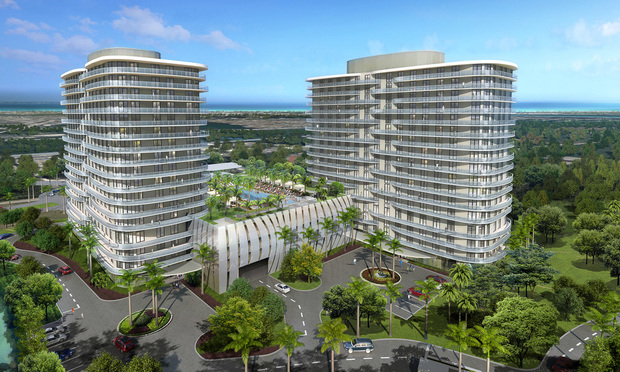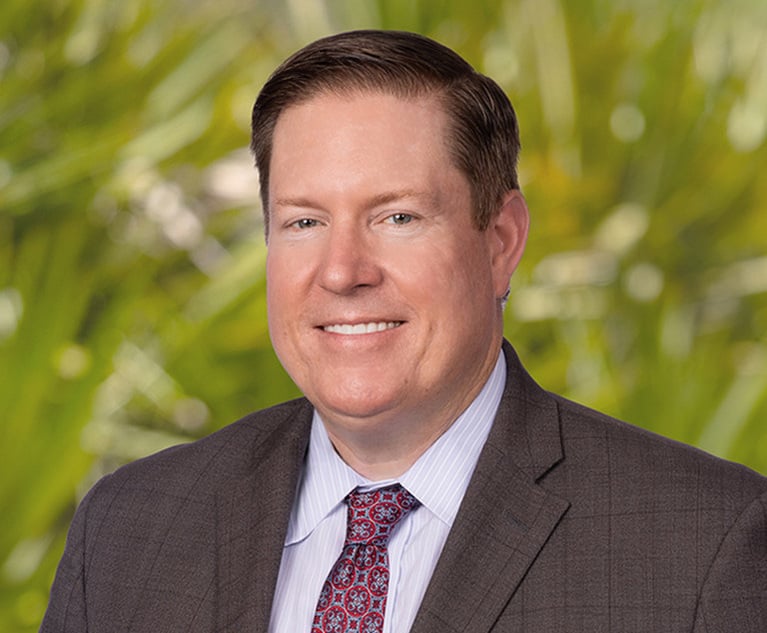Florida Paradise Offers Wealthy Developers a Big Trump Tax Break
Since 2015, the LeFrak and Soffers families, two of America's wealthiest real estate clans, have been developing a $4 billion community called Solé Mia in North Miami.
April 15, 2019 at 01:14 PM
8 minute read
 The SoLeMia Miami development to rise in North Miami will include residences, restaurants, shopping and a hotel. The first part of the project, two 17-story residential towers with a parking garage and amenities, will be finished in this summer. Courtesy of SoleMia Miami.
The SoLeMia Miami development to rise in North Miami will include residences, restaurants, shopping and a hotel. The first part of the project, two 17-story residential towers with a parking garage and amenities, will be finished in this summer. Courtesy of SoleMia Miami.
The sun was rising and the coffee flowing as billionaire developer Richard LeFrak welcomed guests to his Hamptons home last August for one of the season's more unusual gatherings: a “salon discussion” about a new tax break.
The star of the exclusive event was Treasury Secretary Steven Mnuchin, there to explain a key piece of President Donald Trump's signature tax overhaul. Investors developing real estate or funding businesses in some 8,700 struggling communities designated as “opportunity zones” would get big breaks to boost their returns. The administration expected the incentives to pump $100 billion into long-overlooked parts of the country.
But for LeFrak, a longtime friend of Trump, it represented a potential windfall for a project he'd been working on well before the president was elected.
Since 2015, his family and the Soffers, two of America's wealthiest real estate clans, have been developing a $4 billion community called Solé Mia in North Miami, Florida. The 184-acre “live, work, play paradise” is already taking shape and is slated to include a dozen residential towers, a swimmable lagoon, a medical center, shops and a Jaguar dealership — on what used to be a Superfund site.
The new law has set off a frenzy among developers to start projects that might qualify, but LeFrak's company and its partners were way ahead. They lobbied city officials and the administration of Florida's then-governor, Rick Scott, to support designating the census tract encompassing Solé Mia an opportunity zone. That effort prevailed, beating out numerous other communities that hoped to be included.
Those moves position LeFrak and the development's other backers to reap significant tax breaks. Two people with knowledge of Solé Mia, who asked not to be identified discussing the private plans, estimated the new law may boost the project's returns by more than $100 million. Stu Loeser, a spokesman for LeFrak, said that figure is too high. Ultimately, it will hinge on how developers fund their stakes, how many apartments they sell as condos and how the property market performs.
“To date, the project has received no benefits from the opportunity zone program, and it's not clear that it will ever be able to or to what degree,” said Florence Quinn, a spokeswoman for Oleta Partners, the joint venture developing Solé Mia. “What is clear are the benefits the surrounding community will receive from this development,” including jobs and a “massive influx of new property tax revenue that's already started,” she said.
LeFrak never discussed Solé Mia or opportunity zones with the president, and only learned about the incentives after the legislation passed in December 2017, Loeser said.Both Democrats and Republicans have heralded opportunity zones as a new and potent economic development tool. Investors claim the breaks by taking capital gains they've already earned and deploying them in the distressed areas. But critics worry the law is written so loosely it will become a handout to the wealthy, juicing returns on projects they would have pursued anyway. Others question whether poor people living in the zones will benefit.
Perhaps no other investment embodies this tension more than Solé Mia. It could rank among the largest opportunity zone projects in the country, showcasing how investors can give a jolt to struggling communities. Household incomes in North Miami, where most residents are black, lag regional and national averages.
Yet, the development probably would have been built without the tax breaks. And, because of a mismatch between municipal and census boundaries, an impoverished area that helped Solé Mia qualify as an opportunity zone may not see some of the gains.
Few investors had even heard of opportunity zones at the start of last year when representatives for Solé Mia met with Governor Scott's staff to explain why their project should be eligible for the breaks, according to a person familiar with the effort. The development could be a catalyst for the city, turning a giant, underused parcel between Fort Lauderdale and Miami into a significant source of new tax revenue, they argued. The developers eventually expanded their pitch, encouraging officials in North Miami to push for the zone they wanted as well as several others, the person said.
The outreach was timely. Early in 2018, governors were rushing to nominate zones to the Treasury Department. By law, they could only select a quarter of the eligible low-income census tracts, setting off a scramble by municipalities, developers, nonprofits and others to influence the process. Florida officials were ultimately inundated with more than 1,000 requests.
“I was definitely being lobbied,” said Cissy Proctor, then executive director of Florida's Department of Economic Opportunity, the agency spearheading Scott's selections. She didn't remember any particular request from Solé Mia, but said the state worked hard to run a transparent process that resulted in a “strong program overall in the state.”
The agency analyzed data and listened to pitches, giving extra weight to suggestions from cities and counties, said Erin Gillespie, former deputy chief of staff of the department, who now runs an opportunity zone consulting firm. “We really trusted local governments to know what was best,” she said.
On that front, the LeFraks and Soffers had found a willing partner in North Miami City Manager Larry Spring, who already knew about opportunity zones when the developers got in touch.
“The day it passed, our federal lobbyist called and said, 'There's something in the code that you need to see,'” Spring recalled. An accountant by training, he saw opportunity zones as a way to accelerate the redevelopment of a part of his city that had languished for years and to significantly expand North Miami's tax base. “Over a 30-year window, you're talking about hundreds of millions of dollars,” Spring said.
The development also promises scores of construction jobs, as well as permanent work at the businesses moving in. Costco Wholesale Corp. recently relocated a store to Solé Mia, and the University of Miami Health System announced in February it's opening a facility there.
Seeing the potential, Spring urged Scott in a letter to nominate 10 zones in his city, including the one with Solé Mia. He didn't prioritize them. While it isn't clear whether Scott was aware of the lobbying, he later sent a list to Treasury that included the tract the LeFraks and Soffers wanted. Only two other zones in North Miami were selected — one of them adjacent to the zone with Solé Mia.
Scott, now a U.S. senator, didn't respond to requests for comment about Solé Mia or how he picked which zones to nominate.
To claim the tax breaks, investors start by taking capital gains they've earned elsewhere and pump them into new real estate projects or businesses inside a zone. That defers what they owe the government until the end of 2026 and can ultimately reduce it. Meantime, their new investment can grow tax-free if held for a decade or more.It's possible that it won't make sense for Solé Mia's backers to claim the benefit, said Loeser, the spokesman for LeFrak. The perk can become less attractive if it prevents developers from claiming breaks on the depreciation of the property or if investors decide to hold their stakes much longer than a decade.Opportunity zone regulations are still being ironed out, which could also complicate the development's ability to claim the benefits. Only investments made after the tax law passed can qualify, curtailing the breaks for the money already plowed into the site. Still, with hundreds of millions, if not billions, left to be invested, the families could have ample opportunity to use the incentives.
Noah Buhayar reports for Bloomberg News. Jonathan Levin and Lauren Leatherby assisted with this report.
This content has been archived. It is available through our partners, LexisNexis® and Bloomberg Law.
To view this content, please continue to their sites.
Not a Lexis Subscriber?
Subscribe Now
Not a Bloomberg Law Subscriber?
Subscribe Now
NOT FOR REPRINT
© 2025 ALM Global, LLC, All Rights Reserved. Request academic re-use from www.copyright.com. All other uses, submit a request to [email protected]. For more information visit Asset & Logo Licensing.
You Might Like
View All
Mediating Community Association Disputes: Tips for Attorneys, and Their Clients
6 minute read

Cole, Scott & Kissane Keeps Transitioning More Resources Into Construction As Tort Reform Changes Loom
4 minute readTrending Stories
- 1'A Death Sentence for TikTok'?: Litigators and Experts Weigh Impact of Potential Ban on Creators and Data Privacy
- 2Bribery Case Against Former Lt. Gov. Brian Benjamin Is Dropped
- 3‘Extremely Disturbing’: AI Firms Face Class Action by ‘Taskers’ Exposed to Traumatic Content
- 4State Appeals Court Revives BraunHagey Lawsuit Alleging $4.2M Unlawful Wire to China
- 5Invoking Trump, AG Bonta Reminds Lawyers of Duties to Noncitizens in Plea Dealing
Who Got The Work
J. Brugh Lower of Gibbons has entered an appearance for industrial equipment supplier Devco Corporation in a pending trademark infringement lawsuit. The suit, accusing the defendant of selling knock-off Graco products, was filed Dec. 18 in New Jersey District Court by Rivkin Radler on behalf of Graco Inc. and Graco Minnesota. The case, assigned to U.S. District Judge Zahid N. Quraishi, is 3:24-cv-11294, Graco Inc. et al v. Devco Corporation.
Who Got The Work
Rebecca Maller-Stein and Kent A. Yalowitz of Arnold & Porter Kaye Scholer have entered their appearances for Hanaco Venture Capital and its executives, Lior Prosor and David Frankel, in a pending securities lawsuit. The action, filed on Dec. 24 in New York Southern District Court by Zell, Aron & Co. on behalf of Goldeneye Advisors, accuses the defendants of negligently and fraudulently managing the plaintiff's $1 million investment. The case, assigned to U.S. District Judge Vernon S. Broderick, is 1:24-cv-09918, Goldeneye Advisors, LLC v. Hanaco Venture Capital, Ltd. et al.
Who Got The Work
Attorneys from A&O Shearman has stepped in as defense counsel for Toronto-Dominion Bank and other defendants in a pending securities class action. The suit, filed Dec. 11 in New York Southern District Court by Bleichmar Fonti & Auld, accuses the defendants of concealing the bank's 'pervasive' deficiencies in regards to its compliance with the Bank Secrecy Act and the quality of its anti-money laundering controls. The case, assigned to U.S. District Judge Arun Subramanian, is 1:24-cv-09445, Gonzalez v. The Toronto-Dominion Bank et al.
Who Got The Work
Crown Castle International, a Pennsylvania company providing shared communications infrastructure, has turned to Luke D. Wolf of Gordon Rees Scully Mansukhani to fend off a pending breach-of-contract lawsuit. The court action, filed Nov. 25 in Michigan Eastern District Court by Hooper Hathaway PC on behalf of The Town Residences LLC, accuses Crown Castle of failing to transfer approximately $30,000 in utility payments from T-Mobile in breach of a roof-top lease and assignment agreement. The case, assigned to U.S. District Judge Susan K. Declercq, is 2:24-cv-13131, The Town Residences LLC v. T-Mobile US, Inc. et al.
Who Got The Work
Wilfred P. Coronato and Daniel M. Schwartz of McCarter & English have stepped in as defense counsel to Electrolux Home Products Inc. in a pending product liability lawsuit. The court action, filed Nov. 26 in New York Eastern District Court by Poulos Lopiccolo PC and Nagel Rice LLP on behalf of David Stern, alleges that the defendant's refrigerators’ drawers and shelving repeatedly break and fall apart within months after purchase. The case, assigned to U.S. District Judge Joan M. Azrack, is 2:24-cv-08204, Stern v. Electrolux Home Products, Inc.
Featured Firms
Law Offices of Gary Martin Hays & Associates, P.C.
(470) 294-1674
Law Offices of Mark E. Salomone
(857) 444-6468
Smith & Hassler
(713) 739-1250







